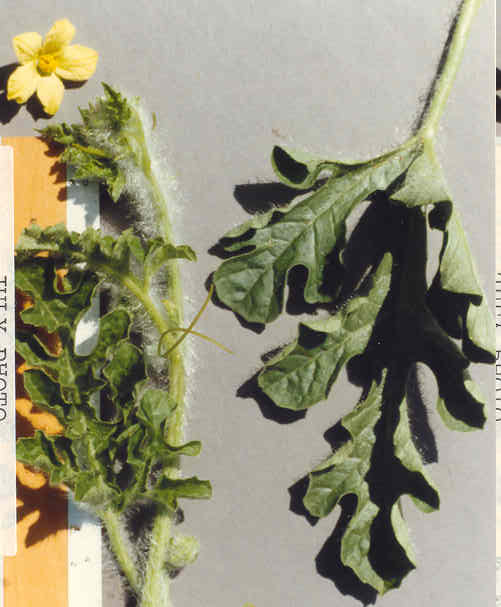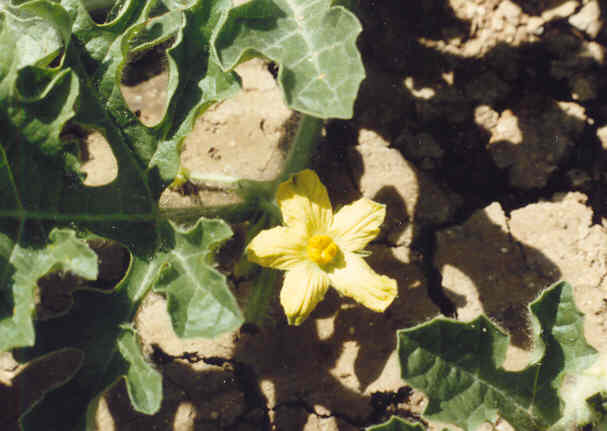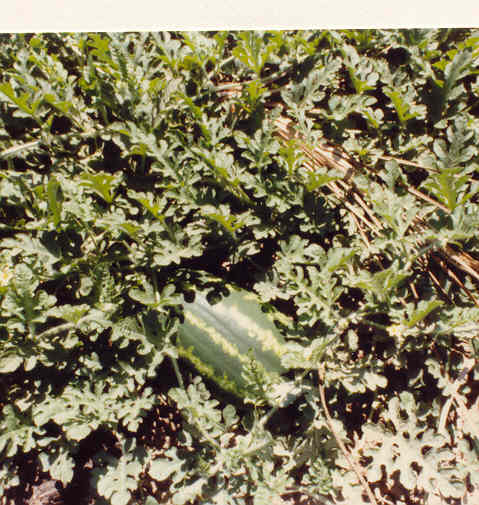
 |
Citrullus colocynthis (L.) Schrad. var. lanatus (Thumb.) Matsum & Nakai=Citrullus lanatus var. lanatus=Citrullus vulgarisCucurbitaceae (Gourd Family)AfricaWatermelon |
June Photo
Plant Characteristics:
Monoecious annual, +/- hairy, with long trailing stems bearing branched
tendrils; lf. blades ovate in outline, 3-8 cm. long, pinnately divided into 3-4 pairs of lobes, these again lobed
and toothed, the segms. broad at apex; corolla ca. 4 cm. in diam., 5-parted
nearly to base; ovary with 3-placentae and many ovules; stigmas 3;
fr. hemispherical to ellipsoid, hard, smooth, green striped; seeds white
to black, in a sweet red to greenish or white flesh.
Habitat:
Occasional escape from cult. Bloom
dates not given in Munz, but would normally be summer. (my comment).
Name.
Latin diminutive of citrus,
having a similar odor and flavor. (Munz,
Flora So. Calif. 391). Latin, lanatus,
wooly. (Jaeger 136). The species
name probably refers to the hairy leaves and stems. (my comment).
Latin, colo, to inhabit and cynthus,
the birthplace of Apollo and Diana. (Simpson 116, 165). Colocynthis,
to inhabit a place of the Gods, possibly referring to the sweet fruit.
(my comment).
General:
Rare in the study area, having been found only once, and this in the
Santa Ana Heights area near Jamboree Rd. (my
comment). Although
an Old World plant, watermelons appear to have preceded the Spanish advance into
the Southwest. Father Kino reported
watermelons being grown by the Indians at Las Sandias near the Gila junction as
early as 1700. Other Spanish
explorers observed watermelon being grown by Colorado River tribes, including
Juan Bautista de Anza whose expedition was offered three thousand watermelons by
the Yuma Indians. Watermelons were
mentioned as being grown by the Cahuilla, Indians of the Colorado Desert, the
San Jacinto and San Bernardino Mountains, near present-day Thermal by Don Jose
Maria Estudillo, a member of the first Spanish expedition to cross Coachella
Valley. The Cahuilla ate
watermelons fresh or cut peel into strips and dried them for winter use.
They may also have buried watermelon in sand for short-term storage as
was done by some of the Colorado River Tribes.
(Bean and Saubel 55).
About. 4 species of trop. Old World.
(Munz, Flora So. Calif.
391). John
Johnson believes that there was an active trade between the Indians of the
southwest and the Aztecs and Central Americans.
Two hundred years had elapsed between the time the Spanish were first in
Mexico until they entered California and the Colorado River regions, allowing
for the dispersal of watermelon seeds.
Text Ref:
Bailey 954; Hickman, Ed.
536; Munz, Flora So. Calif. 391.
Photo Ref:
June-July 87 # 21,22,23; July-Aug 87 # 18.
Identity: by R. De Ruff.
First Found: July 1987.
Computer Ref: Plant Data 302.
Have plant specimen.
Last edit 5/6/05.
 |
 |
July Photo August Photo